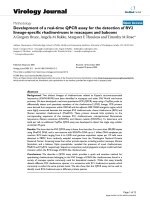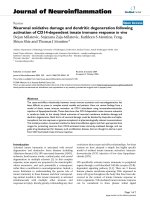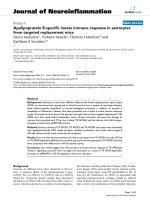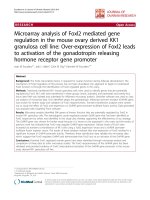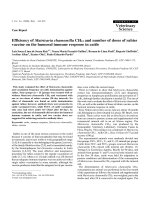Detection of cell mediated immune response in chickens immunized with Eimeria tenella Sporozoites
Bạn đang xem bản rút gọn của tài liệu. Xem và tải ngay bản đầy đủ của tài liệu tại đây (173.12 KB, 5 trang )
Int.J.Curr.Microbiol.App.Sci (2017) 6(5): 1513-1517
International Journal of Current Microbiology and Applied Sciences
ISSN: 2319-7706 Volume 6 Number 5 (2017) pp. 1513-1517
Journal homepage:
Original Research Article
/>
Detection of Cell Mediated Immune Response in Chickens
Immunized with Eimeria tenella Sporozoites
S. Saravanan*, K.M. Palanivel, T.J. Harikrishnan and G. Selvaraju
Department of Veterinary Preventive Medicine, Veterinary College and Research Institute,
Tamil Nadu Veterinary Animal Sciences University, Namakkal-637 002, Tamil Nadu, India
*Corresponding author
ABSTRACT
Keywords
Broiler chickens,
E. tenella
sporozoites, ELISA,
CMI, Lesion score,
Bodyweight.
Article Info
Accepted:
17 April 2017
Available Online:
10 May 2017
Purified E. tenella sporozoites were administered subcutaneously in neck region of
broiler chickens in different age groups and the cell mediated immune response in
terms of gamma interferons by ELISA was assessed. The mean IFN-γ
concentration (pcg) in this experimental trial was significantly higher (P<0.01) in
T4 (226.61±6.41) and lower in T1 (159.73±2.37) than other groups. On 49th day of
age, the concentration declined but higher in group T4 (154.65± 3.66) than the
other groups. The mean weekly weight gain (g) after challenge was high in T4
(2342.50±42.483) with a low mean lesion score (2.5±0.22). A partial protective
cellular immune response against caecal coccidiosis with a mean bodyweight gain,
and mean lesion score superior to the unimmunized infected chickens could be
observed in this study.
Introduction
The Indian poultry sector has become a major
contributor to the national economy as a result
of the revolutionary and scientific approaches
in avian health care management. Indian
poultry industry contributes nearly Rs. 9.9
billion annually to the national economy
(Mohana Subramanian et al., 2010). In India,
broiler chicks are reared in deep litter system
under farm condition which leads to frequent
occurrence of the disease and face maximum
economic loss due to reduced body weight
gain, followed by increased feed conversion
ratio (23.74%) and chemoprophylaxis
(2.83%) due to coccidiosis (Bera et al., 2010),
and the annual losses due to coccidiosis
burden was estimated to be more than $ 800
million worldwide (Kitandu and Juranova,
2006). Coccidiosis has long been known as
important in poultry, and even today, control
requires significant financial expenditure
(Chapman, 2003).
Chickens are susceptible to at least 9 species
of coccidia and the most common species is
E. tenella, which causes caecal coccidiosis,
while E. acervulina and E. maxima, cause
chronic intestinal coccidiosis (Chandrakesan
et al., 2009). Caecal coccidiosis is most
frequent in young birds, especially at the age
of four weeks (Soulsby, 1982). Currently, the
increasing incidence of drug resistance to
field strains of coccidian and residual effects
1513
Int.J.Curr.Microbiol.App.Sci (2017) 6(5): 1513-1517
in the poultry meat or eggs, poses a serious
problem for producers (Peek and Landman,
2011). Obviously an alternative system to
control coccidiosis is by vaccination,
however, use of sporulated oocysts as live
vaccines has limited application (Vermeulen
et al., 2001) necessitating alternate
immunological approaches to control the
disease.
In this context, this paper presents the
assessment of potency of the E. tenella
sporozoites administered by parenteral route
in broiler chickens, by enzyme linked
immunosorbent assay (ELISA) by detecting
cell mediated immune response and the
efficacy in terms of bodyweight and lesion
score in immunized broilers.
Materials and Methods
In this experimental trial, five groups of day
old Cobb 400 broiler chicks were used (n=15)
and purified sporozoite antigen was
administered subcutaneously @ 0.1 ml per
bird in the neck region, to groups T1 to T4
and T5 was kept as control. Groups, T1 and
T2 were administered 10 and 20 µg of live
sporozoite antigen, respectively on 2nd day of
age, and T3 and T4 were administered 10 and
20 µg of live sporozoite antigen, respectively
on 6th day of age by subcutaneous route in the
neck region. The project proposal of this
research programme to conduct these studies
was duly approved by Institutional Animal
Ethics Committee (IAEC) of Veterinary
College and Research Institute, Namakkal.
The sera collected from experimental trial
were subjected to ELISA specific to chicken
gamma interferons (IFN-γ) for assessment of
cell mediated immune response. The assay
was carried out as per the standard protocol of
the manufacturer (Cusa Biotech Ltd, China).
The concentration of IFN-γ in the samples is
then determined by comparing the O.D. of the
samples to the standard curve. The duplicate
readings for each standard, control, and
sample were averaged and subtracted from
the average zero standard optical density. A
standard curve was generated using the
professional soft ―Curve Exert 1.3‖ by
reducing the data to generate a four parameter
logistic (4-PL) curve-fit. The data were
linearized by plotting the log of the IFN-γ
concentrations versus the log of the O.D. and
the best fit line can be determined by
regression analysis. The concentrations of the
test samples were derived from the following
equation, Rational Function: y= (a+bx) /
(1+cx+dx^2).
Where, a,b,c and d from the co efficient data
are variables which vary based on the fitness
of standard curve derived from the test
standards of each test. Statistical analysis was
performed by randomized block design
(Snedecor and Cochran) and analysis of
variance (ANOVA) with SPSS statistical
software (version 10.01). The results obtained
in the experimental trial are shown in table 1
and figure 1. The potency of the sporozoite
vaccine in terms of cell mediated immune
response and efficacy in terms of bodyweight
and lesion score after challenge with 10, 000
live E. tenella oocysts at 49 days of age were
assessed.
Results and Discussion
In the present study, the mean IFN-γ
concentration (pcg)
was
significantly
(P<0.01) high in T4 (226.61±6.41) followed
by T2 (218.78±5.91), T3 (165.5±5.55) and T1
(159.73±2.37). High concentrations in T2 and
T4 observed at 14 days of age started
declining thereafter. T1 and T3 showed high
concentration at 7 days of age but started
declining thereafter and this early decline
might be due to the low antigenic dose in the
vaccine when compared to T2 and T4.
1514
Int.J.Curr.Microbiol.App.Sci (2017) 6(5): 1513-1517
Treatment
Groups
Table.1 Assessment of cell mediated immune response by IFN-γ based ELISA
T1
T2
T3
T4
T5
Gamma interferon concentration in Pcg (Mean ± SE)
7th day
159.73BT±2.37
204.57CST±10.7
165.50BRS±5.55
192.75CRS±3.12
10.39Apq±1.01
14th day
117.08BR±4.56
218.78CT±5.91
120.51BR±2.92
226.61CST±6.41
8.41Apq±0.51
21st day
142.92CS±3.66
171.81DQR±5.12
108.41BRQ±3.85
182.95DRS±5.96
10.33Apq±0.31
28thday
155.79CDT ±4.26
162.94CDQ ±6.00
119.91BR±3.12
134.59BCP±2.90
10.87Apq±0.43
35th day
82.51BQ±3.8
188.74DRS±2.17
75.51BP±2.45
150.57CQ±4.61
10.87Apq±0.61
42nd day
54.58BP±3.23
156.82DQ±5.69
93.39CQ±4.06
164.28DQ±3.65
10.86Apq±0.49
49th day
62.76BP±2.52
91.41CP±2.69
67.53BP±5.25
154.65DQ±3.66
12.33Aq±0.54
**Row-wise mean (±SE) with different superscript (pqr…) differ significantly (P< 0.05), mean bearing ‗upper case‘ superscript in a row are
highly significant (P< 0.01); *Column- wise mean (±SE) with different superscript (abc…) differ significantly (P< 0.05), mean bearing ‗upper
case‘ superscript in a column is highly significant (P< 0.01).
Fig.1 Mean ELISA IFN-γ levels in chickens of experimental trial
1515
Int.J.Curr.Microbiol.App.Sci (2017) 6(5): 1513-1517
The mean IFN-γ concentrations between
weeks within each group were significantly
different (P<0.01) when compared to control
group. This finding is in concordance with
that of Breed et al. (1999) and Prowse et al.
(1991).
However, the IFN-γ concentration (pcg) on
day 49 was higher in T4 (154.65± 3.66),
followed
by
T2
(91.41±2.69),
T3
(67.53±5.25) and T1 (62.76±2.52) in this
experimental trial. The mean IFN-γ
concentration in T4 and T2 were significantly
high (P<0.01) than that of other vaccinated
groups and this could probably be due to the
higher antigenic dose administered to T4 and
T2 than T1 and T3.
The mean weekly weight gain (g) after
challenge, at 56 days of age was high in T4
(2342.50±42.483)
followed
by
T2
(2284.50±74.407), T3 (2241.67±67.333) and
T1(2214.67±40.426). The weight gains of all
groups were found to be superior to that of
unimmunized infected T5, however, inferior
to that of unimmunized uninfected T5.
Similar findings were recorded by Conway et
al., (1990) and Kawazoe (2000). However,
these weight gains were not significantly high
(P>0.05) when compared to unimmunized
infected
T5
(2278.20±85.418)
but
significantly (P<0.05) low when compared to
unimmunized
uninfected
T5
(2518.83±38.704). A low mean lesion score
was observed in T4 (2.5±0.22) followed by
T2 (2.83±0.17), T1 (3.33±0.33) and T3
(3.00±0.45) in comparison with unimmunised
infected T5 (3.33±0.33) thus indicating a
partial protection (P>0.05) by the sporozoites.
A similar observation was recorded by
Ziomko et al., (2005) and Geriletu et al.,
(2011). Interferons have been reported to be
inimical to parasites, probably because of
their ability to inhibit parasite development
(Lillihoj and Choi, 1998), promote production
of free radicals (Dimier and Bout, 1997) and
activate antibody-dependent
cytotoxicity (Fleischer, 1980).
cell-mediated
Hence, it is concluded that immunization of
broiler chickens of less than a week old by
parenteral administration with E. tenella
specific sporozoites could result in an early
but partially protective cellular immune
response against caecal coccidiosis with a
mean bodyweight gain, and mean lesion score
superior to the unimmunized infected
chickens.
Acknowledgement
The authors are grateful to the TamilNadu
Veterinary and Animal Sciences University,
Chennai, TamilNadu, India for providing
necessary financial assistance to carry out this
research programme and the Dean of
Veterinary College and Research Institute,
Namakkal, TamilNadu, India for providing
immense support and necessary facilities to
carry out this research work.
References
Bera, A.K., D. Bhattacharyaa, D. Pana, A.
Dharab, S. Kumarc and Das. S.K. 2010.
Evaluation of economic losses due to
coccidiosis in poultry industry in India.
Agri. Economics Res. Rev., 23: 91-96.
Breed, D.G.J., T.P.M. Schetters, N.A.P.
Verhoeven, A. Boot-Groenink, J.
Dorrestein and Vermeule, A.N. 1999.
Vaccination against Eimeria tenella
infection using a fraction of E. tenella
sporozoites selected by the capacity to
activate T cells. Int. J. Parasitol., 29:
1231-1240.
Chapman, H.D. 2003. Origins of coccidiosis
research in the fowl—the first fifty
years. Avian Dis., 47: 1–20.
Chandrakesan, P., K. Muralidharan, V.
Dinesh Kumar, G. Ponnudurai, T.J.
Harikrishnan, K. Senthilvel and Rani,
1516
Int.J.Curr.Microbiol.App.Sci (2017) 6(5): 1513-1517
N. 2009. Efficacy of a herbal complex
against caecal coccidiosis in broiler
chickens. Veterinarski Arh., 79: 199203.
Conway, D.P., McKenzie, M., Elizabeth &
Dayton, A.D. 1990. Relationship of
coccidial lesion scores and weight gain
in infections of Eimeria acervulina, E.
maxima and E. tenella in broilers. Avian
Pathol., 19: 489 - 496.
Dimier, I.H., and Bout. D.T. 1997. Inhibition
of Toxoplasma gondii replication in IFN
activated human intestinal epithelial
cells. Immunol. Cell Biol., 75: 511–514.
Fleischer, B. 1980. Effector cells in avian
spontaneous and antibody-dependent
cell-mediated cytotoxicity. J. Immunol.,
125: 1161–1166.
Geriletu, B., L. Xua, Xurihuab and Li, X.
2011. Vaccination of chickens with
DNA vaccine expressing Eimeria
tenella MZ5-7 against coccidiosis. Vet.
Parasitol., 177: 6–12.
Kawazoe, U. 2000. Coccidiose. In: A.
Berchieri, M. Mcari, editors. Doenca
das aves. Campinas: Facta, pp: 391405.
Kitandu, A. and Juranova, R. 2006. Review
Article: Progress in Control Measures
for
Chicken
Coccidiosis.
Acta
Veterinaria Brno, 75: 265–276.
Lillehoj, H.S. and Choi, K.D. 1998.
Recombinant chicken interferongammamediated inhibition of Eimeria tenella
development in vitro and reduction of
oocyst production and body weight loss
following Eimeria acervulina challenge
infection. Avian Dis., 42: 307–314.
Mohana Subramanian, B., V. Lakshmipriya,
A. Ramesh, T.J. Harikrishnan and
Rajan, S. 2010. Sequence diversity of
iternal transcribed spacer-1(ITS-1)
region of Eimeria infecting chicken and
its relevance in species identification
from Indian field samples. Parasitol.
Res., 106: 513-521.
Peek, H.W. and Landman, W.J.M. 2011.
Coccidiosis in poultry: anticoccidial
products, vaccines and other prevention
strategies. Vet. Quarterly, 31: 143-161.
Prowse, S.J. 1991. Cell-mediated immunity to
Eimeria in the fowl: The absence of
cross-species protection is not due to the
lack of cross-reactive T cells. Int J.
Parasitol., 21:133-135.
Soulsby, E.J.L. 1982. In: Helminths,
arthropods
and
protozoa
of
domesticated animals. Seventh Edition,
Bailliere Tindall, London.
Vermeulen, A.N., D.C. Schaap, and Schetters,
T.P.M. 2001. Control of coccidiosis in
chickens by vaccination, Vet. Parasitol.,
100: 13-20.
Ziomko, I., J. Karamon, T. Cencek, E.
Gornowicz, A. Skoracki, and Ashash,
U. 2005. Prevention of broiler chick
coccidiosis using the inactivated subunit
vaccine coxabic®. Bull. Vet. Institute in
Pulawy, 49: 299-302.
How to cite this article:
Saravanan, S., K.M. Palanivel, T.J. Harikrishnan and Selvaraju, G. 2017. Detection of Cell
Mediated Immune Response in Chickens Immunized with Eimeria Tenella Sporozoites.
Int.J.Curr.Microbiol.App.Sci. 6(5): 1513-1517. doi: />
1517

